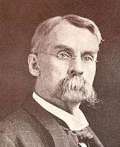True knowledge consists in becoming acquainted with and understanding the nature and quality of a remedy, its appearance, its image and its relation to man in his sickness; then by studying the nature of sickness in the human family to compare that sickness with symptoms of the Materia Medica. By this means we become acquainted with the law of cure and all it leads that it leads to, and formulate doctrines by which the law may be applied and made use of, by arranging the truth in form to be perceived by the human mind.
This is but the science and we may, notwithstanding, fail to heal the sick. You will observe some, who know the science, go out and make improper application of the remedies, and seem to have no ability to perceive in a remedy that which is similar to a disease. I believe if they had a candid love for the work they would over come this, but they think more of their pocket books. The physician who is the most successful is he who will first heal for the love of healing, who will practice first for the purpose of verifying his knowledge and performing his use for the love of it.
I have never known such a one to fail, This loves stimulates him to proceed and not to be discouraged with his first failures, and leads him to success, in simple things first and then in greater things if he did not have an unusual affection for it he would not succeed in it. An artist once was asked how it was that the he mixed his pains so wonderfully, and he replied, “With brains, sir.” So one may have all the knowledge of Homoeopathy that it is possible for a human being to have, and yet be a failure in applying that art in its beauty and loveliness. If we have no affection for it, it will be seen to be a mere matter of memory and superficial intelligence.
As he learns to love it, and dwell upon it as the very life of him, then he understands it as art and can apply it in the highest degree. The continuous applications of it will lead any physician of ordinary intelligence so far into the perception of his work that he will be able to perceive by the symptoms the whole state of the economy, and when reading provings to perceive the very nature of the sickness expressed in the provings. This degree of perception will enable him to see the “outwardly reflected image.” You will not have to observe long, or be among physicians long before you will find that many of them have a most external memory of the Materia Medica, that they have no idea of the nature of medicine they use, no perception of the quality or image of a remedy.
It does not come up before their mind as an artist’s picture; it is cold, it is far away. An artist works on a picture so that he sees it day and night, he figures it out from his very affections, he figures out every line that he is going to put in the next day, stands before it and he is delighted in it and loves it. So it is with the image of a remedy. That image comes out before the mind so that it is the outwardly reflected image of the inner nature, as if one man had proved it. If the symptoms do not take form the physician does not know his patient and does not know his remedy. This is not a thing that can open out to the mind instantly.
You are, as it were coming out of a world where the education consists in memorizing symptoms or memorizing key-notes or learning prescriptions, with really nothing in the mind, and the memory is only charged with a mass of information that has no application, and is only confusion leading man to worse confusion. There is no order in it. Hahnemann says: “In a word, the totality of the symptoms must be the principal, indeed the only thing the physician has to take note of in every case of disease, and to remove by means of his art, in order that it shall be cured and transformed into health.” That is the turning of internal disorder into order manifested in the way we have heretofore explained, viz., from above downward, from within out and in the reverse order of the coming of the symptoms.

